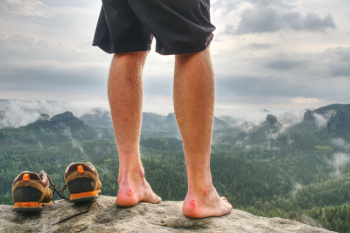 Blisters on the feet, though seemingly minor, can lead to more serious complications if not treated properly. These small pockets of fluid form as a result of friction or pressure, commonly from wearing ill-fitting shoes or increased physical activity. While they often heal on their own, blisters can become infected. Infections are indicated by increased pain, redness, swelling, or the presence of pus. It is important to seek medical attention if there are signs of infection, which can escalate into cellulitis, a deeper, more serious skin infection that can spread quickly. For individuals with diabetes or compromised immune systems, the risk of complications from foot blisters is significantly higher. These conditions can impair blood circulation and wound healing, making even small blisters potential gateways to severe infections. If you have a blister that is showing signs of infection, especially if a blister is not healing as expected, it is suggested that you schedule an appointment with a podiatrist as quickly as possible.
Blisters on the feet, though seemingly minor, can lead to more serious complications if not treated properly. These small pockets of fluid form as a result of friction or pressure, commonly from wearing ill-fitting shoes or increased physical activity. While they often heal on their own, blisters can become infected. Infections are indicated by increased pain, redness, swelling, or the presence of pus. It is important to seek medical attention if there are signs of infection, which can escalate into cellulitis, a deeper, more serious skin infection that can spread quickly. For individuals with diabetes or compromised immune systems, the risk of complications from foot blisters is significantly higher. These conditions can impair blood circulation and wound healing, making even small blisters potential gateways to severe infections. If you have a blister that is showing signs of infection, especially if a blister is not healing as expected, it is suggested that you schedule an appointment with a podiatrist as quickly as possible.
Blisters are prone to making everyday activities extremely uncomfortable. If your feet are hurting, contact Franklin Harry, DPM of Best Foot Forward. Our doctor can provide the care you need to keep you pain-free and on your feet.
Foot Blisters
Foot blisters develop as a result of constantly wearing tight or ill-fitting footwear. This happens due to the constant rubbing from the shoe, which can often lead to pain.
What Are Foot Blisters?
A foot blister is a small fluid-filled pocket that forms on the upper-most layer of the skin. Blisters are filled with clear fluid and can lead to blood drainage or pus if the area becomes infected.
How Do Blisters Form?
Blisters on the feet are often the result of constant friction of skin and material, usually by shoe rubbing. Walking in sandals, boots, or shoes that don’t fit properly for long periods of time can result in a blister. Having consistent foot moisture and humidity can easily lead to blister formation.
Prevention & Treatment
It is important to properly care for the affected area in order to prevent infection and ease the pain. Do not lance the blister and use a Band-Aid to provide pain relief. Also, be sure to keep your feet dry and wear proper fitting shoes. If you see blood or pus in a blister, seek assistance from a podiatrist.
If you have any questions, please feel free to contact our offices located in Festus and St. Louis, MO . We offer the newest diagnostic and treatment technologies for all your foot care needs.
